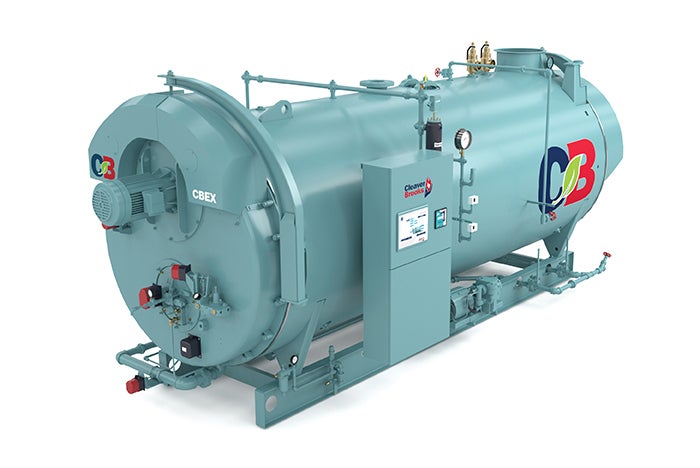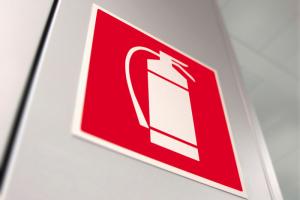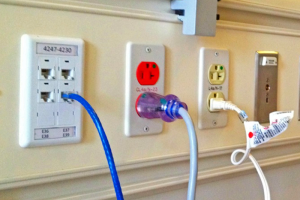Hospital steam system functions and operations
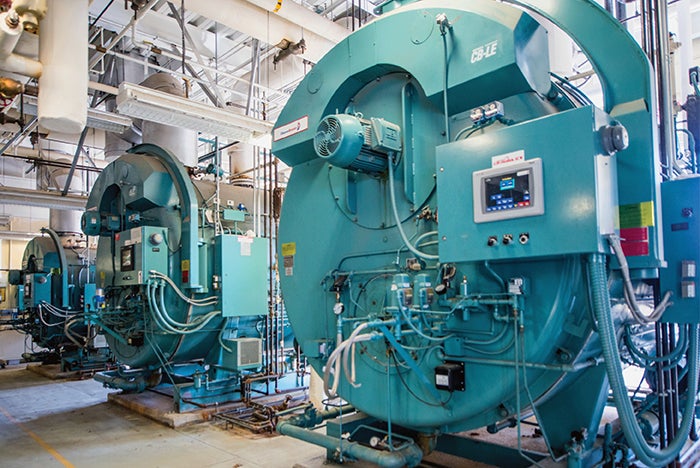
A centralized multiple boiler plant is often beneficial for facilities that intend to utilize steam for multiple uses across a large service area.
Image courtesy of ASHE
In the ever-evolving landscape of health care facilities management, there are many reasons that steam has endured the test of time for more than a century. With very few viable alternatives, steam plays a crucial role in supporting two modern health care requirements — sterilization and humidification.
Regulatory authorities, including the Centers for Disease Control and Prevention (CDC), have recognized steam as a preferred method for sterilization in health care applications because it provides the “largest margin of safety due to its reliability, consistency, lethality and least effect from organic/inorganic soils,” according to the chapter “Disinfection, Sterilization, and Control of Hospital Waste” in the book, Mandell, Douglas, and Bennett’s Principles and Practice of Infectious Diseases.
Steam can also support a range of additional functions, including heating, hot water, food service and laundry.
Given this variety, there is no one-size-fits-all approach for steam systems in health care facilities. One of the biggest considerations is whether to use localized or centralized distribution. Additionally, it is vital to keep in mind that steam system processes need to be closely controlled and monitored.
Sterilization and humidification
Although boiling water and producing steam is an ancient practice, precisely controlling that process to produce a specific flow rate of steam at a specific pressure and temperature requires careful planning, installation and operation of the steam system. If not done properly, it can have destructive and even deadly consequences.
Steam produced for use in health care facilities is often referred to as saturated steam or dry steam. Although the terms “saturated” and “dry” seem contradictory, they both apply, as steam exists at the saturation temperature but does not contain water particles. Of all available sterilization methods, moist heat in the form of saturated steam under pressure is the most widely used and considered the most dependable.
According to a 2020 American National Standards Institute (ANSI) blog on the ANSI/Association for the Advancement of Medical Instrumentation ST79, Guide to Steam Sterilization, “Saturated steam under pressure is one of the oldest and safest methods used in health care facilities to sterilize medical devices.”
The basic principle of steam sterilization, as accomplished in an autoclave, is to expose each item to direct steam contact at the required temperature and pressure for the specified time — a process that is supported by steam’s ability to achieve a higher heat content than water, according to the “Steam Sterilization” section in the CDC’s “Guideline for Disinfection and Sterilization in Healthcare Facilities,” published in 2008.
Steam contains no living organisms, so it is inherently sterile and nontoxic to patients, staff and the environment. It is also an inexpensive resource, kills microorganisms and spores, and can penetrate fabrics and various packaging as well as quickly heat to high temperatures.
Like all sterilization processes, steam sterilization can have a corrosive effect on instruments, potentially causing rust or damage after repeated exposure. Additionally, due to its high heat, steam can cause burns if not properly controlled.
On the other hand, humidity is an important topic in health care facilities because when indoor air is too dry — or has relative humidity (RH) levels generally below 30% — occupants can be faced with several health hazards and facility issues, including the extended airborne transmission of viruses, worsening of respiratory illnesses, skin irritation and damage to electronics through electrostatic discharges.
In recent years, certain viruses like influenza and human coronavirus have demonstrated increased infection rates in lower RH, according to the article “Relative Humidity and Its Impact on the Immune System and Infections” in the June 2023 International Journal of Molecular Sciences and the article “Associations between indoor relative humidity and global COVID-19 outcomes” in the November 2022 Journal of The Royal Society Interface.
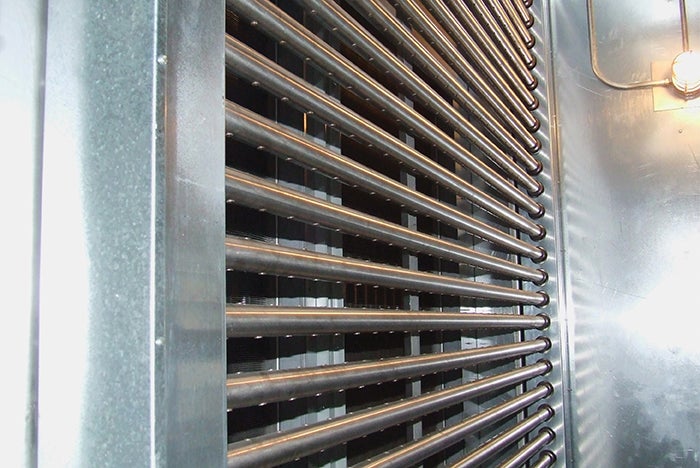
A centralized multiple boiler plant is often beneficial for facilities that intend to utilize steam for multiple uses across a large service area.
Image courtesy of ASHE
Industry standards — like the ANSI/ASHRAE/American Society for Health Care Engineering (ASHE) Standard 170, Ventilation of Health Care Facilities, and policies from the Facility Guidelines Institute, The Joint Commission and the Centers for Medicare & Medicaid Services — typically set RH levels for health care facilities at a minimum of 30% and a maximum of 60%.
Steam has been found to be one of the few effective, reliable tools in raising humidity in health care environments, according to the CDC’s “Guidelines for Environmental Infection Control in Health-Care Facilities: Recommendations of CDC and the Healthcare Infection Control Practices Advisory Committee (HICPAC).” Through the proper use of Food and Drug Administration-approved corrosion-inhibiting chemicals, steam is suitable for direct use in humidification. While adiabatic humidification has recently been approved for use in health care environments by the latest version of ANSI/ASHRAE/ASHE Standard 170, it remains untested relative to the substantial evidence behind the effectiveness of steam.
Benefits and risks
In addition to those mentioned previously, steam offers several other fundamental benefits for health care facility design and operations. These benefits include:
- Close control. The temperature of steam is directly related to its pressure and is therefore easily controlled. Steam can also be distributed long distances with minimal effect on the pressure or temperature.
- Energy efficiency. Steam is distributed by its own pressure, requiring no mechanical devices or pumps and consequently no associated electrical costs. Steam is therefore able to move large amounts of energy throughout a facility quickly, easily and efficiently — drastically lowering the energy load in comparison to hot water systems. This is particularly applicable to health care facilities that operate 24/7, producing a very high energy demand.
- Spatial flexibility. Steam requires much smaller pipes than water to produce the same energy load and does not need space for circulation pumps. Steam pipe sizes can be reduced by providing local pressure reduction to steam generated at a higher pressure than required by the terminal process. Additionally, steam distribution systems are not affected by a building’s height.
However, there are also risks to consider when dealing with the high temperature and moisture levels associated with steam. If not expertly regulated and controlled, steam can be a dangerous force. Potential risks include:
- Condensate. The condensate that results from steam releasing its heat must be properly managed to maintain the quality (i.e., dryness) of the steam, maximize heat transfer, prevent water hammer, and minimize makeup water and chemical treatment costs.
- Corrosion. Removal of the dissolved oxygen in the makeup water for a steam boiler through chemical treatment and/or by heating is required to reduce corrosion.
- Monitoring. Boilers generating steam at greater than 15 pounds per square inch gauge (psig) pressure may require continuous monitoring by a certified technician, depending on the requirements of the applicable boiler code. Additionally, all boilers should be regularly monitored and maintained.
- Pipe expansion. The expansion of piping due to the high temperature of steam must be compensated with pipe guides, anchors, expansion loops/compensators and other equipment.
- Pipe insulation and slope. Sufficiently thick steam piping insulation is critical for minimizing the formation of condensate and to prevent personnel injury. Steam and condensate return piping must also be sloped to facilitate the flow of condensate by gravity.
- Trap maintenance. Steam traps must be maintained to ensure successful condensate management. Properly sizing and selecting traps will help keep the steam as dry as possible, as undersized or oversized traps can lead to system defects.
Types of systems
The previous discussions on sterilization and humidification make it obvious that steam is a necessary utility in a hospital. The challenge for owners and their design teams when planning a new facility is whether to produce the steam in one location to serve all the needs within the facility (i.e., centralized) or to produce the steam at individual sites throughout the facility where it is required (i.e., localized).
Generally, the smaller the facility, the more effective localized steam can be in that facility. Additionally, localized steam is often beneficial for single-use applications. However, because steam produced locally is typically generated with electricity as the fuel source — particularly for sterilization — the impact on a facility’s electrical infrastructure and utility costs can be significant.
Centralized steam systems are often beneficial for facilities that will utilize the steam for multiple uses and across a larger service area. When it comes to developing a centralized steam system, it must be tailored to a facility’s specific needs, requirements and regulations.
Design pressure and pressure control are two essential factors to consider when designing any steam system. The design or operating pressure is maintained by the steam-producing equipment itself and must be sufficient to meet the requirements of all processes and the distribution system throughout the facility.
For example, humidifiers typically operate at low pressure (less than 15 psig), but sterilizers will require higher pressures (typically 50 to 75 psig), and therefore the design pressure would need to be a minimum of 50 to 75 psig.
Moreover, the steam produced at 50 to 75 psig to meet the needs of the sterilizers exceeds the needs of the humidifiers and therefore must be reduced (i.e., controlled) to 15 psig. This is typically accomplished by multiple pressure reducing valves arranged in a station that can have one or more stages of pressure reduction, depending on the amount required.

A combination deaerator and surge tank with a modified feedwater pumping configuration allows the surge tank to bypass the deaerator when it is out of service for maintenance./p>
Image courtesy of ASHE
A central system’s required redundancy will also vary by facility. Most often, N+1 redundancy systems are utilized on boilers and feedwater pumps. With an N+1 system, the “N” stands for the minimum number of modules required for a system to function, and the “1” refers to the number of additional components that serve as a backup, equipping the system to operate if one of the modules within N fails. For example, if a system requires five power supply modules, an N+1 power system may include six power modules. Deaerator (DA) tanks, devices required in a centralized steam system to provide heated and deoxygenated makeup water to the boilers, should also have N+1 redundancy to accommodate yearly preventive maintenance needs. An alternative is a combination DA and surge tank with a modified feedwater pumping configuration, allowing the surge tank to bypass the DA when it is out of service.
In this vein, condensate recovery systems are becoming more prevalent as managers seek to optimize energy efficiency. Collecting hot condensate and returning it to the boiler feed system can pay for itself in a short time, reducing water charges as well as associated possible cooling costs and fuel costs. Boiler blowdown is also minimized with less energy lost from the boiler, and chemical treatment of makeup water is reduced with less water lost from the boiler. Ultimately, condensate recovery systems allow more steam to be produced by a central system, using less water.
The Department of Energy (DOE) also encourages the use of feedwater economizers to optimize energy and reduce steam boiler fuel requirements through the recovery of waste heat, according to a DOE tip sheet titled “Use of Feedwater Economizers for Waste Heat Recovery.”
Economizers transfer heat from the system’s flue gas to incoming feedwater. This helps capture additional heat from the flue gas which can be more than 100 to 150 F higher than the temperature of the generated steam that would otherwise be rejected to the atmosphere, decreasing total energy usage. The DOE estimates that boiler efficiency can be increased by 1% for every 40-degree reduction in flue gas temperature. It is also estimated that an economizer can reduce fuel requirements by 5% to 10% and pay for itself in less than two years. Additionally, the International Code Council’s International Energy Conservation Code has updated insulation requirements, requiring more stringent insulation thickness than traditional designs — 5 to 6 inches thick, depending on the pressure and pipe size.
For safety, steam piping accessories should always be insulated. Removable insulation blankets work best to accommodate maintenance needs for valves, traps and similar units.
The power of steam
Steam systems can be complicated to navigate and require careful deliberation of the associated risks and considerations.
Yet, the use of steam in helping health care facilities achieve sanitized, non-toxic, energy-efficient and regulatory-compliant environments is nearly unrivaled in its effectiveness.
Engaging in conversations with industry professionals who are equipped with steam-specific expertise can help facilities managers ensure their facilities are harnessing the power of steam in a way that is safe, effective and efficient.
Gavin Green, PE, is a senior mechanical engineer in Smith Seckman Reid’s (SSR’s) Nashville, Tenn., office, and Lee M. Nordholm, PE, LEED AP, is a senior mechanical engineer in SSR’s Dallas office. They can be contacted at ggreen@ssr-inc.com and lnordholm@ssr-inc.com.


